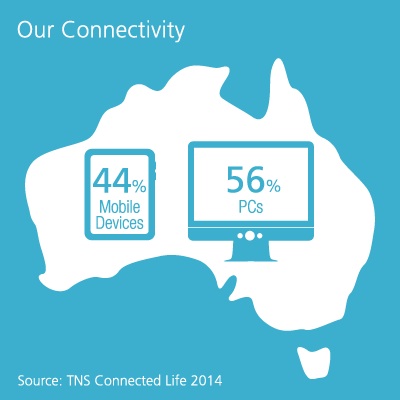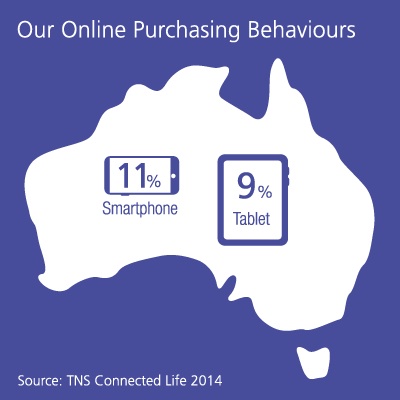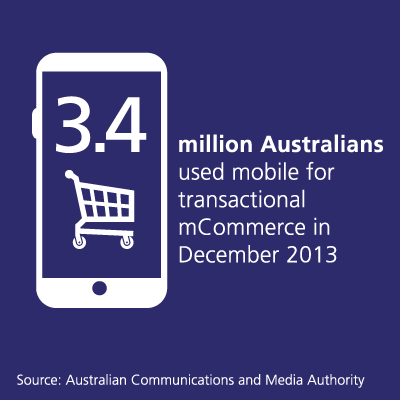 As Australians rapidly embrace online shopping, the Australian Communications and Media Authority has revealed 3.4 million of us used mobile for transactional m-commerce activities in December 2013 – a 448 per cent increase in three years.
As Australians rapidly embrace online shopping, the Australian Communications and Media Authority has revealed 3.4 million of us used mobile for transactional m-commerce activities in December 2013 – a 448 per cent increase in three years.
With one of the world’s highest smartphone penetration rates, the time is (still) ripe for brands and retailers to develop fully consumer centric (meaning mobile centric) strategies.
The evolving m-commerce ecosystem can enhance customer experiences and is already having a distinct influence on Australian retail, with 11 per cent of online purchasing time via smartphone and nine per cent via tablet – behaviour that will become more prevalent as we use increasingly capable pocket computers.
Retailers are already driving growth by making shopping faster, more convenient and more personal through innovations like click and collect, instore mobile interaction, and mobile sites. Mobile sites are far from a complete solution, however. A more fundamental planning shift is required to keep pace with how the intersection of online shopping, m-commerce and instore experience changes shopping patterns.
TNS Connected Life 2014 found Australians spend 44 per cent of connected time on mobile devices, so we remain, albeit narrowly, PC centric at heart.
Aussies have plentiful smartphone technology at hand, but just over half of us still opt for PCs or laptops, subject to situation. Our PC centricity is also informing mobile marketing to extend reach and frequency, rather than fundamentally changing mobile’s role.
Retailers who will lead the m-commerce revolution will be those catering to users on all sorts of devices and on users’ terms – much more than an app or mobile usable site.
Right now your audience is shopping on PCs and mobiles, but do you know what mobile people seek versus what PC people need?
Are there clues about proximity to purchase – are they just trying to find your store or checking stock? Can they order from you via mobile with in-store fulfillment?
A tyre retailer recently revealed to me that 20 per cent of their traffic was mobile – to a non-mobile optimised site. Their realisation that their customers were adamant about shopping via a mobile channel meant their content, layout, contact mechanisms, and advertising had to adapt to meet users’ needs – customers shopping at home, on the road, and instore.
Driving mobile strategy through your legacy website can mask an inherently conservative approach to digital planning. The importance of delivering optimised handset experiences and serving different content to mobile users is recognised, but mobile experiences often remain a ‘versionalised’ extension of PC experiences.
Close investigation into the digital routines of mobile centric consumers reveals that this doesn’t go nearly far enough – they engage more touch points on their journey, of which a mobile retailer site is but one of many.
So while Australia is a PC centric market overall, one fifth of online consumers already exhibit mobile centric behaviours – skewing towards young people, affluent people, and women.
Targeting these demographics requires strategies reflecting known behaviours. With 86 per cent of connected mobile time spent using apps, implying pure m-web visibility is at a premium, we must conceive of ‘addressable mobile time’ more broadly.
Mobile centric consumers follow their own rhythm of media consumption: small engagement moments focused on specific tasks and apps cumulatively dominating share of time online.
Developing clear, concise, compelling, and valuable content that delivers immediate engagement and quickly communicates messages is critical, as is delivering interactivity and finding a place within app-based handset experiences.
Mobile centric consumers use a select few apps daily, each with a distinct role, so target them through these installed apps. Identify and work with those already delivering core experiences. These partnerships can take a number of forms, from readily available advertising opportunities to native content and value add functions and interactivity.
For example, a Department of Veterans’ Affairs campaign driving registrations for tickets to attend the Gallipoli 100th anniversary used unique media targeting products with strong, interactive, mobile specific creative. The value of this mobile ready cross channel strategy saw their mobile target of registrations double.
In another innovative usage of mobile technology, Universal Sony Home Entertainment leveraged the unique relationship between consumers and mobiles using a voice response campaign to launch a DVD release – the first time Australians interacted with mobile ad units using natural speech, allowing brands to have a semblance of dialogue with consumers.
Investigating partnerships with existing shopper apps and, for those who have done their audience homework, leveraging the next stage of location analytics with instore technologies like BLE beacons, will keep you at the forefront of this evolving mobile centric world of instant gratification.
Peter Firth is a director at TNS, the world’s largest shopper insights agency. He advises on growth strategies around new market entry, innovation, brand switching, and stakeholder management.








